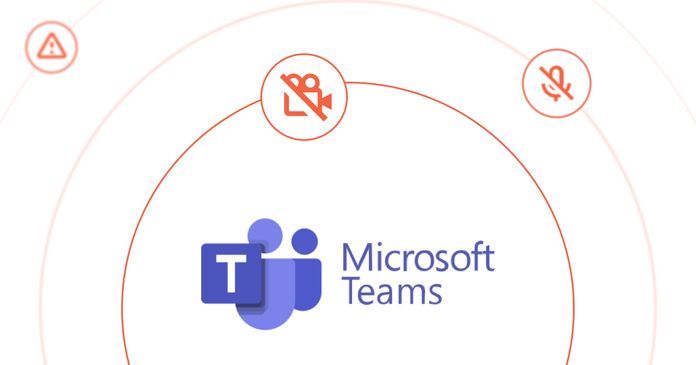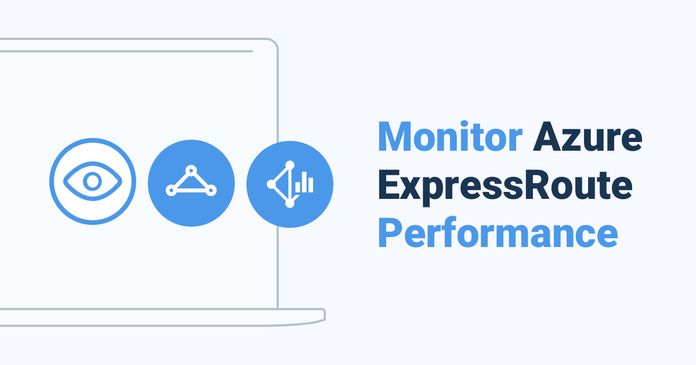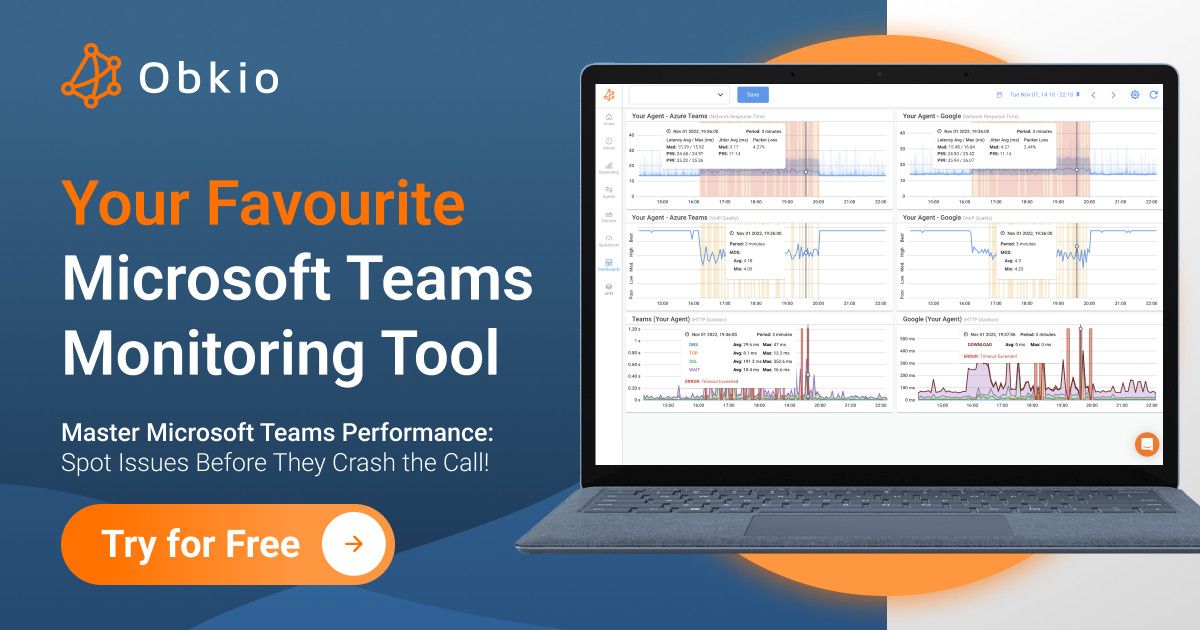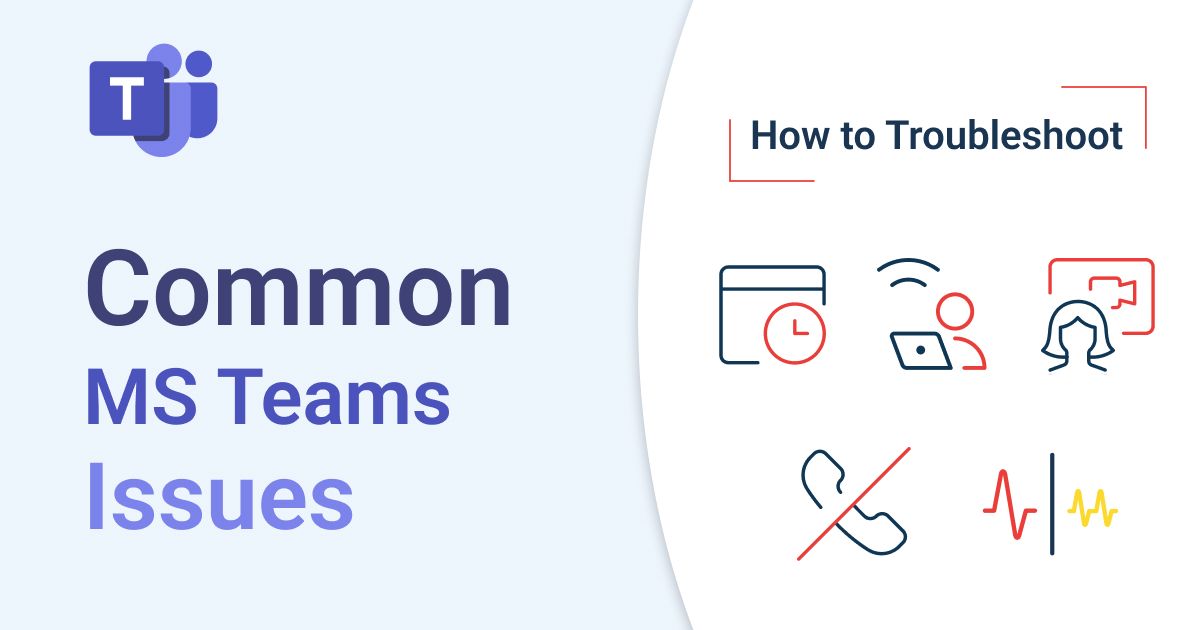Table of Contents
Table of Contents
Microsoft Teams has become the collaboration backbone for businesses worldwide. But when call quality drops during a crucial client meeting or files won't upload before a deadline, productivity grinds to a halt. The frustration? These issues are usually preventable.
The challenge with Teams is that problems can originate from multiple sources: user devices, network infrastructure, or Microsoft's platform itself. Without proper monitoring, IT teams waste hours troubleshooting the wrong things while users suffer through poor call quality and slow performance.
The reality of Microsoft Teams issues:
- 75% are network-related (bandwidth, latency, packet loss)
- 24% stem from user devices (CPU, memory, hardware)
- Less than 1% are Microsoft platform issues
This means most Teams problems are detectable and fixableif you're monitoring the right metrics from the right perspectives.
In this guide, you'll learn how to implement comprehensive Microsoft Teams monitoring that identifies issues before they impact users. We'll cover what to monitor, how to set it up, and how to quickly diagnose problems using data instead of guesswork.
Whether you're troubleshooting current issues or building a proactive monitoring strategy, this guide provides the framework for maintaining seamless Teams performance across your organization.
Monitoring Teams Monitoriing involves tracking different components, including user activities, server health, network conditions, security, compliance, and overall system functionality. The primary objectives of Microsoft Teams Monitoring is to identify and address issues, enhance user experience, ensure security and compliance, and optimize the overall performance of the collaboration platform.

- Smooth Operations: When you rely on Microsoft Teams for day-to-day communication and collaboration, any performance issues can cause disruptions. Monitoring ensures that your Teams platform runs smoothly, minimizing downtime and keeping productivity levels high.
- Proactive Troubleshooting: Instead of waiting for users to report problems, monitoring allows you to identify issues before they become significant. This proactive approach enables IT teams to resolve potential bottlenecks and glitches, preventing larger-scale disruptions.
- User Experience Enhancement: By keeping an eye on Teams' performance, you gain insights into how users interact with the platform. Understanding their experience helps you tailor the platform to their needs, optimizing the way they work together.
- Security and Compliance: Monitoring allows businesses to detect potential security risks and ensure compliance with data protection regulations. This keeps sensitive information safe and protects your business from potential threats.
- Resource Allocation: Tracking Teams' usage and performance helps you understand resource requirements better. It allows you to allocate resources efficiently and optimize your IT infrastructure.
- Cost Optimization: Efficient monitoring helps you identify areas where you might be overspending on resources or underutilizing certain features. This insight enables cost optimization while maintaining a high level of productivity.
Microsoft Teams Monitoring is the secret sauce that makes your business run smoother, collaborate smarter, and safeguard your valuable data.
Microsoft Teams Monitoring is a broad term that encompasses the observation and analysis of various aspects of the Microsoft Teams platform to ensure its smooth operation. While Microsoft Teams Monitoring is a comprehensive approach that includes various facets of overseeing the entire ecosystem, Microsoft Teams Performance Monitoring narrows its focus to aspects directly affecting the performance and responsiveness of the platform.
Microsoft Teams performance monitoring involves measuring and analyzing specific metrics related to user interactions, server response times, network latency, client-side performance, and call quality. The main goals of Microsoft Teams Performance Monitoring include optimizing the speed and reliability of Teams services, ensuring low Microsoft Teams latency during audio and video calls, and enhancing the overall performance of the application for end-users.
Both Microsoft Teams Monitoring and Microsoft Performance Teams Monitoring are critical for maintaining a healthy and efficient collaboration environment, but performance monitoring is a subset of the broader monitoring strategy, emphasizing the optimization of user experience and system efficiency.
Beyond standard network monitoring, Obkio now offers specialized Teams monitoring that actually tests Teams functionality:
How It Works: Every minute, Obkio's Monitoring Agents join Teams meetings, exchange audio and video data for 35 seconds, then gather performance metrics from three perspectives:
- User Environment: CPU, memory, device performance
- Network Infrastructure: Latency, jitter, packet loss, bandwidth
- Microsoft Platform: Call quality reports from Microsoft's API

Complete Coverage: Monitors 99% of the Teams call path—from user devices through your network, ISP, and into Microsoft's Azure infrastructure.
Instant Diagnosis: When issues occur, three-perspective correlation instantly shows whether problems are user-related (high CPU), network-related (packet loss), or Microsoft-related (API errors).

In this step-by-step tutorial, we'll walk you through the process of setting up Microsoft Teams monitoring like a pro so you can start identifying and troubleshooting Microsoft Teams performance issues and improving your end-user experience.
There are different tools and techniques your business can leverage for Microsoft Teams monitoring, but for this tutorial, we’re going to focus on Network Monitoring.
You know how crucial Teams is for your business. But here's the catch: your Teams experience is only as good as your network performance. That's where a dedicated Microsoft Teams Monitoring tool comes to the rescue!
As Teams operates in a cloud-based environment, the quality of its audio and video calls, file sharing, and real-time collaboration heavily relies on a stable and high-performing network infrastructure. With a Network Monitoring tool tailored for Microsoft Teams, businesses can proactively track their network's health, identifying potential bottlenecks or connectivity issues before they disrupt critical communication and collaboration.
Obkio’s Network Monitoring Tool continuously monitors end-to-end network performance from every end of your network, so you can identify network problems in your office, home network, and even the Microsoft network.

- Monitor end-to-end network performance
- Monitor Microsoft network performance for apps like Teams, Azure, Microsoft 365 and more
- Measure network metrics like jitter, packet loss, latency, VoIP Quality and more.
- Identify performance issues affecting Microsoft Teams and network performance.

Obkio performs Microsoft Teams monitoring and network performance monitoring using continuous synthetic traffic from Network Monitoring Agents. These Monitoring Agents are deployed in all ends of your network to measure network metrics, identify network problems and collect the information to help you troubleshoot.
For Microsoft Teams monitoring, you need to use at least 2 types of agents:
- Microsoft Azure Monitoring Agent: Obkio’s Microsoft Azure Monitoring Agent is hosted and maintained by Obkio in the Microsoft Azure cloud infrastructure, which means that it can be deployed within seconds. This Monitoring Agent allows you to monitor network performance between your standard Monitoring Agents and Azure Monitoring Agents, right to the Microsoft Azure platform to identify any network problems affecting Microsoft Teams performance.
- On-Premise Agent: These Monitoring Agents are deployed in your local network, in key network locations like your head office, branch office, data centers and network devices. They allow you to monitor network performance from your end towards Microsoft Teams (and other apps). We recommend the Software (Linux, Windows, Docker) agent that can be installed on your favourite Linux distribution, including Amazon Linux and Amazon Linux 2.
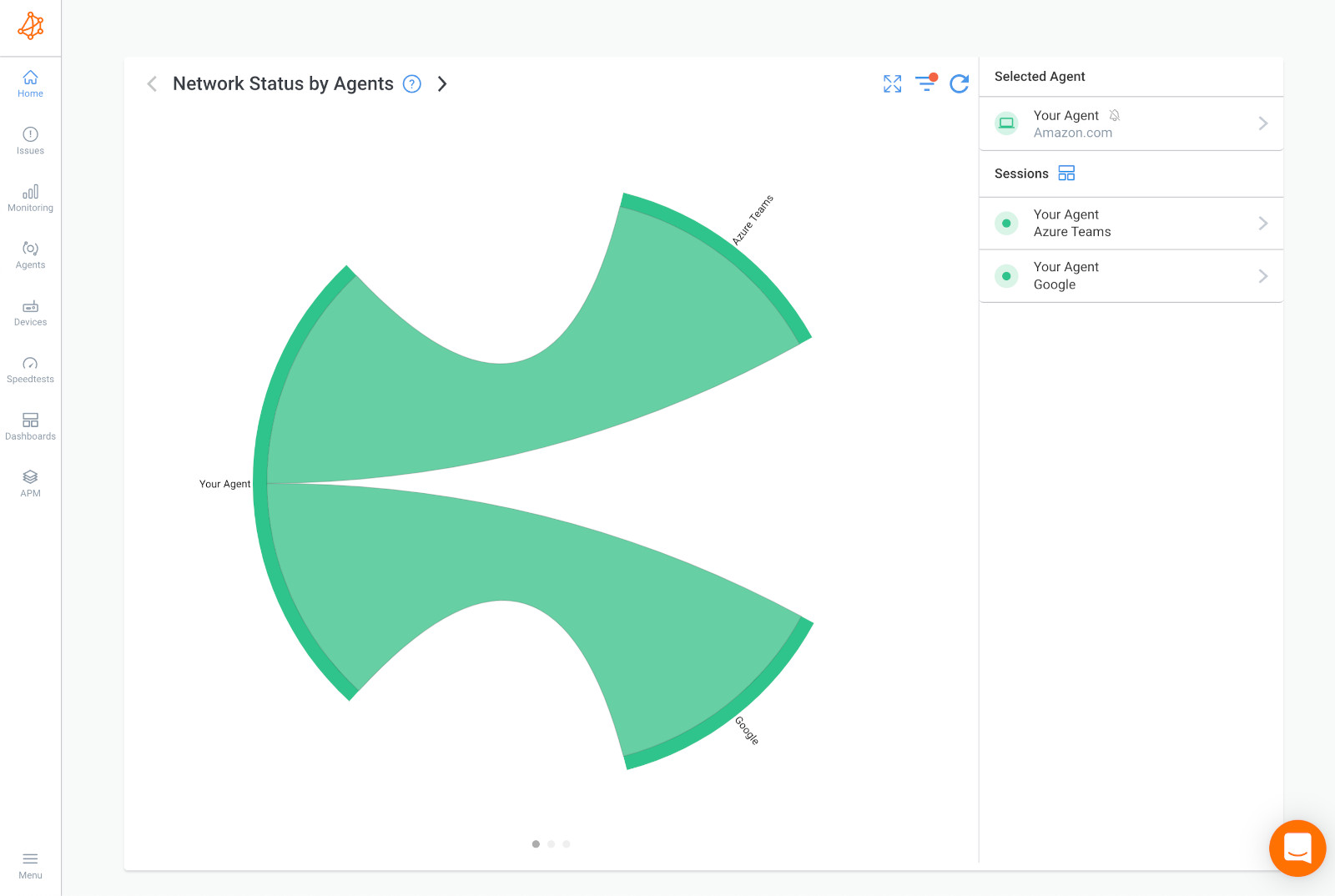
For more information about deploying this Monitoring Agent type, refer to our Documentation.
Microsoft Teams stores customer data in Microsoft's global cloud locations. So, for Microsoft Teams monitoring, it’s important to choose a Monitoring Agent that has been deployed in the Data Center located closest to the Microsoft Data Center closest to you.
For Example:
- You want to monitor Microsoft Teams performance for your business based in Canada, so first, you need to find the location of a Microsoft Data Center in Canada.
- In Canada, Microsoft's Data Centers are located in Quebec City and Toronto - so you need to choose a Public Monitoring Agent hosted closest to one of those locations.
- Obkio’s Microsoft Azure Monitoring Agents are presently located in many locations, including one in Quebec City!
So when you’re deploying your Agent, make sure to choose the Quebec City Azure Agent, to monitor the performance of your Microsoft Teams from Microsoft’s Quebec City Data Center!
You should always deploy a minimum of two Agents to more accurately compare data and identify issues with Microsoft Teams monitoring other network locations.
For example:
- If you’re monitoring Microsoft Teams network performance between your head office and your Internet, use one Agent in your Head Office and 2 Agents to monitor Internet performance (for example, an Azure Agent and an AWS Agent).
- This way, if you have a network problem, you can easily see if that same problem is affecting all your sites or just one.
- If the problem is affecting all your sites, having multiple Agents allows you to collect the most accurate data to troubleshoot, as well as create a comparison point.
And there you have it! The Microsoft Teams setup is as easy as that!
Once you've got your Obkio account all setup and your Monitoring Agents deployed, you're on your way to a whole new level of network nirvana. These trusty Agents aren't just sitting around twiddling their virtual thumbs – they're in action, 24/7. Imagine them as your diligent messengers, zipping back and forth, orchestrating a symphony of synthetic traffic. Their mission?
To measure the performance between your network's various nooks and crannies, your hardworking workstations, and the bustling Microsoft Azure cloud, where all the Teams magic happens.
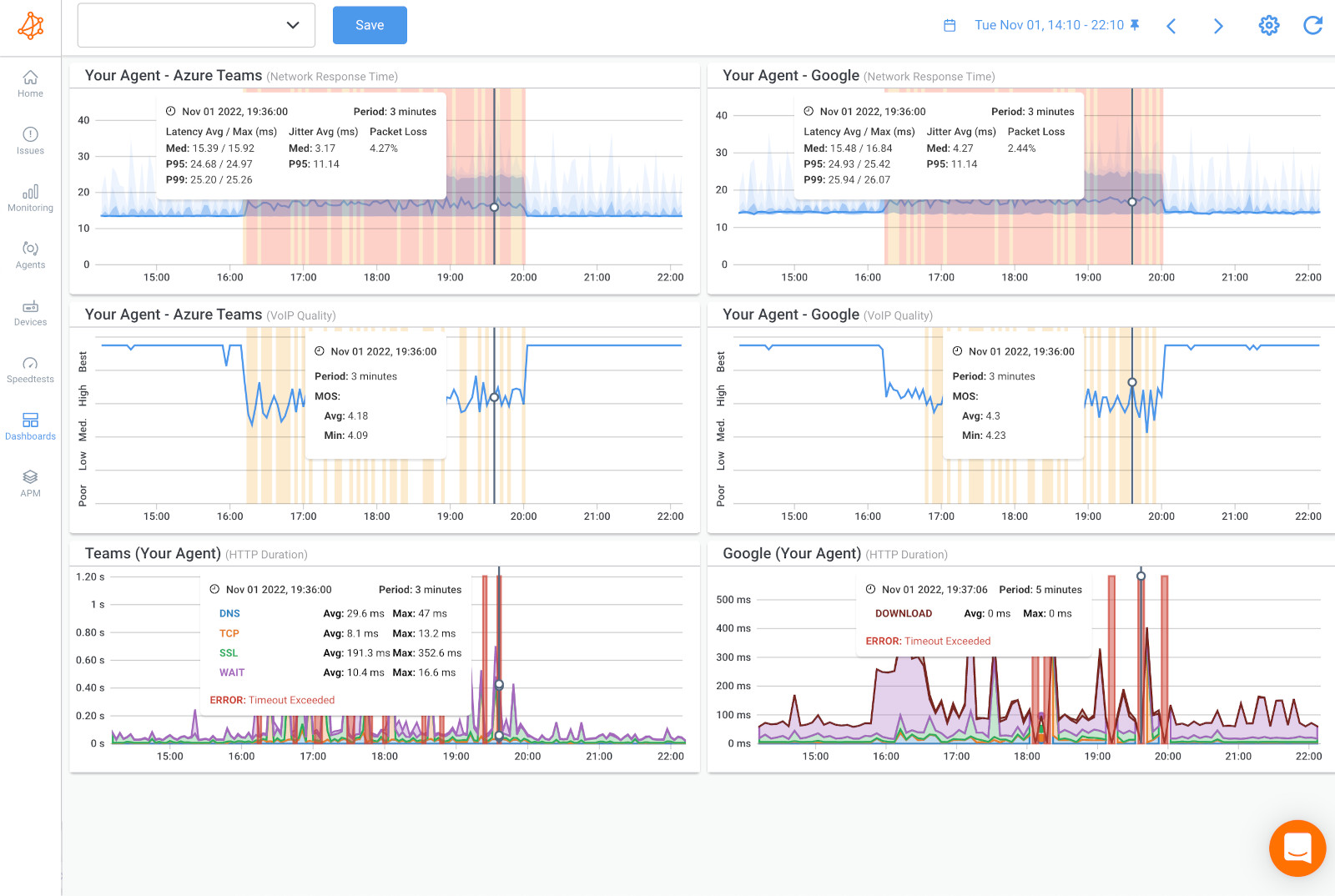
With this savvy setup in place, you're armed and ready to:
- Monitor Key Network Metrics with Precision: Bid farewell to the days of scratching your head over network mysteries. Thanks to the continuous traffic exchange, you'll have a real-time dashboard brimming with insights into critical network metrics that directly impact your Microsoft Teams experience.
- Unearth and Troubleshoot Teams Glitches Like a Pro: No more guesswork when a call goes wonky or a file upload takes a snooze. With your trusty Agents on the case, you'll be the Sherlock Holmes of the digital realm, effortlessly pinpointing and tackling any sneaky performance gremlins.
- Wave Goodbye to Surprise Teams Outages: Be the IT hero your team deserves! With proactive monitoring, you'll get a heads-up on potential Teams hiccups before they have a chance to rain on your collaboration parade. It's like having a crystal ball for your digital landscape.
- Fine-Tune for Top-Notch Performance: Remember the days of slow-loading documents and pixelated video calls? Well, those are officially ancient history. With the insights gathered, you'll have the power to optimize your network and Teams performance, ensuring your end-users are basking in a seamless, frustration-free digital oasis.
Alerts and notifications play a crucial role in Microsoft Teams monitoring, acting as your digital sentinels that keep a watchful eye on the health of your collaboration environment. They serve as proactive messengers, promptly informing you when anomalies or potential outages are detected.
With Obkio, set up Smart Notifications for network events based on a variety of different thresholds. When network performance issues, like packet loss, jitter, bandwidth etc., arise, Obkio will automatically send you notifications with details of what the issue is, where and when it happened, and why.
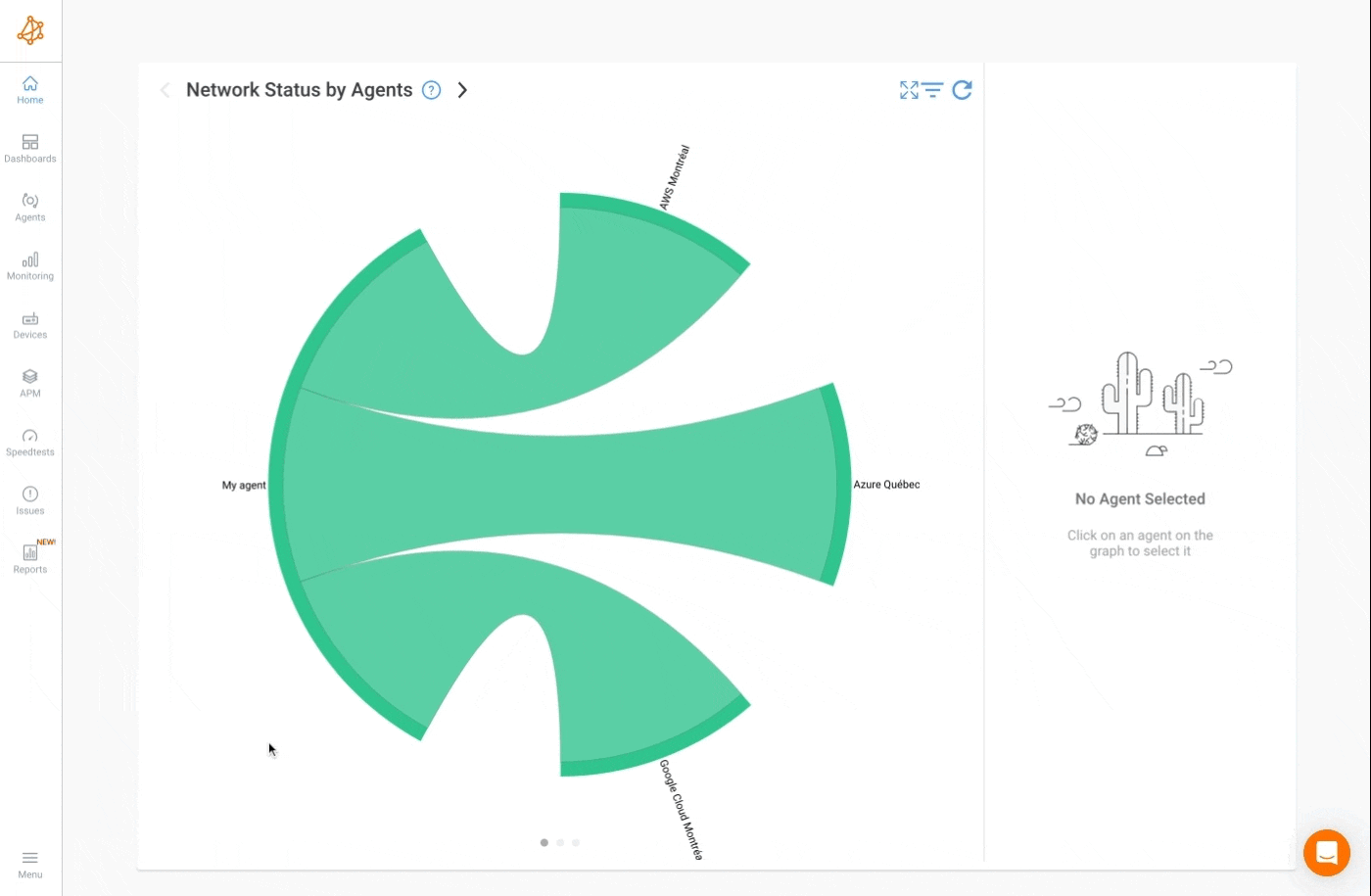
- Early Detection and Proactive Response: Alerts are like vigilant guards stationed at the entrance of your collaboration platform. When they sense something amiss – whether it's a sudden surge in network latency, a spike in packet loss, or a server hiccup – they raise the alarm. By receiving immediate alerts, you're empowered to take action before these anomalies escalate into full-blown disruptions.
- Customizable Thresholds: Obkio’s Monitoring tool allows you to define customized thresholds for various performance metrics. For instance, you can set a threshold for network latency – if latency surpasses this threshold, an alert is triggered. This flexibility ensures that alerts are tailored to your organization's specific requirements and sensitivity levels.
- Multiple Communication Channels: Notifications aren't confined to a single platform. Obkio’s network monitoring alerts can be configured to reach you through various channels, such as email, pagerduty, and even direct collaboration tools like Microsoft Teams and Slack. This multi-channel approach ensures that you receive alerts in a way that best suits your team's workflow.
- Escalation Policies: Sometimes, an alert might need a nudge to grab your attention. That's where escalation policies come into play. If an initial alert goes unnoticed, the system can be set to escalate the alert to higher tiers or different team members, ensuring that critical issues don't slip through the cracks.
- Clear Issue Identification: Alerts don't just inform you that something's wrong; they also provide contextual information. When you receive an alert, you're presented with data and metrics that help you pinpoint the exact nature of the anomaly. This context is invaluable in swiftly diagnosing the issue and determining the appropriate course of action.
- Reduced Downtime: By receiving real-time alerts, you can initiate troubleshooting and remediation efforts promptly. This proactive response minimizes downtime and prevents cascading effects that could impact your users' productivity.
- Preventive Action: Alerts don't just help you address ongoing issues – they also empower you to take preventive action. By identifying trends and patterns in performance data, you can proactively address potential bottlenecks or vulnerabilities before they result in disruptions.
- User Communication: Beyond internal IT teams, alerts can also facilitate effective communication with users. When you're aware of an impending issue, you can notify users in advance, manage expectations, and provide guidance, reducing frustration and enhancing transparency.
- Continuous Improvement: By analyzing historical alert data, you can identify recurring issues and address underlying causes, leading to continuous improvement in your Microsoft Teams environment's performance and stability.
In the dynamic landscape of modern collaboration, alerts and notifications act as your reliable partners, ensuring that you're always informed, equipped, and ready to tackle any challenges that might arise. With their timely guidance, you can navigate the intricate web of Microsoft Teams performance, keeping disruptions at bay and enabling your teams to collaborate seamlessly.
Learn how to keep your Azure cloud connections clear with this deep dive into Azure network monitoring. Optimize your network performance with Obkio.
Learn more

Microsoft Teams Monitoring involves the systematic tracking and analysis of diverse metrics to ensure the optimal functioning of the collaboration platform. This can be done through a Microsoft Teams network assessment and as part of continuous performance monitoring. These metrics are categorized into essential areas, each providing unique insights into different aspects of Teams' performance, user engagement, and system health.
From evaluating the efficiency of servers and network infrastructure to assessing the quality of user interactions during calls and meetings, these metrics collectively empower administrators to maintain a secure, compliant, and high-performing Microsoft Teams environment. Let's delve into these key categories for a holistic approach to effective Teams monitoring.
Microsoft Teams Performance metrics focus on the efficiency of Microsoft Teams, measuring factors such as server response time, client-side processing, and resource utilization. These metrics help ensure that the application runs smoothly and responds promptly to user interactions.
- Server Response Time: Measure the time it takes for Microsoft Teams servers to respond to requests.
- Client-Side Processing Time: Monitor the time it takes for the Teams application to process data on the user's device.
- Application Launch Time: Track how quickly the Teams application launches on different devices.
- Resource Utilization (CPU, Memory): Monitor the CPU usage and memory usage on client devices running Teams.
- Endpoint Connectivity: Monitoring the connectivity status of your workstations and devices helps ensure that they can consistently access and interact with Microsoft Teams.
- Network Path Analysis: Understanding the path that Microsoft Teams data takes through your network helps identify potential bottlenecks or areas for optimization.
Network metrics gauge the health of the communication infrastructure supporting Microsoft Teams. Bandwidth usage, latency, packet loss, and jitter are key indicators, providing insights into the reliability and speed of data transmission.
- Latency: Latency measures the delay in data transmission between endpoints. High latency can lead to delays in audio and video during Teams calls, causing conversations to feel disjointed and frustrating.
- Packet Loss: Packet loss occurs when data packets travelling across the network fail to reach their destination. Excessive packet loss can result in distorted audio, pixelated video, and incomplete file transfers within Microsoft Teams.
- Jitter: Jitter is the variation in delay between data packets arriving at their destination. High jitter can lead to inconsistent audio and video quality during calls and conferencing.
- Bandwidth Utilization: Monitoring bandwidth usage helps ensure that your network has enough capacity to handle Teams' data traffic. Insufficient bandwidth can cause slow file transfers and degrade call quality.
- Network Health: An overall measure of your network's health can provide insights into potential performance issues. It encompasses factors like network uptime, network availability, and general reliability.
- Round-Trip Time (RTT): RTT measures the time taken for a data packet to travel from the sender to the receiver and back. Monitoring RTT helps ensure smooth real-time communication in Teams.
- Quality of Service (QoS) Settings: QoS settings prioritize network traffic to ensure that Teams data packets are given higher priority, minimizing delays and ensuring consistent performance. Qos for VoIP can be especiallu helpful here.

Call quality metrics assess the audio and video performance during Teams meetings and calls. Metrics include audio bitrate, video resolution, and the impact of packet loss and jitter on the overall quality of the communication experience.
- Audio Quality (Bitrate, Codec): Measure the quality of audio calls in terms of bitrate and codec used.
- Video Quality (Resolution, Frame Rate): Monitor the quality of video calls in terms of resolution and frame rate.
- Packet Loss and Jitter during Calls: Track these metrics specifically during audio and video calls.
User activity metrics track how users engage with Microsoft Teams. Monitoring the number of messages sent, meetings attended, and files shared provides valuable insights into collaboration intensity and user participation.
- Number of Messages Sent/Received: Monitor the volume of chat messages to gauge collaboration intensity.
- Meetings Attended/Hosted: Track the frequency and duration of meetings to understand user engagement.
- Files Shared/Accessed: Monitor the sharing and access of files within Teams.
Security and compliance metrics focus on safeguarding Microsoft Teams data and ensuring adherence to regulatory requirements. User authentication logs, compliance violations, and access logs help maintain a secure and compliant collaboration environment.
- User Authentication Logs: Monitor user logins and identify any suspicious login patterns.
- Compliance Violations: Track and audit communications for compliance with regulatory requirements.
- Access Logs: Monitor who has access to specific Teams and channels.
Server health metrics assess the condition of Microsoft Teams servers. Monitoring server availability, error rates, and resource utilization (CPU, memory) ensures the overall stability and reliability of the Teams infrastructure.
- Server Availability: Ensure Teams servers are available and responsive.
- Error Rates: Monitor the rate of errors or failures in server interactions.
- Resource Utilization (CPU, Memory): Track the health of Teams servers in terms of resource usage.
- Server Response Times: Monitoring the response times of Microsoft Teams servers helps ensure that your calls, messages, and data interactions are as seamless as possible.
Client device metrics focus on the devices running Microsoft Teams. Tracking device types, operating system versions, application versions, and device performance (CPU, memory) provides insights into the diversity and health of the client environment.
- Device Type and OS Version: Monitor the types of devices and operating systems running Teams.
- Client Application Version: Track the version of the Teams application on user devices.
- Client Device Performance (CPU, Memory): Monitor resource usage on user devices.
- Firewall and Proxy Performance: Monitoring the performance of firewalls and proxies ensures that they don't introduce bottlenecks or delays in Teams' data traffic.
By understanding and monitoring these metrics, you gain the upper hand in delivering an exceptional collaboration experience for your team. But here's the exciting part: you don't have to venture into this journey alone.
Obkio monitors the most critical subset: network metrics, call quality metrics, and performance metrics, giving you complete visibility into Teams health.
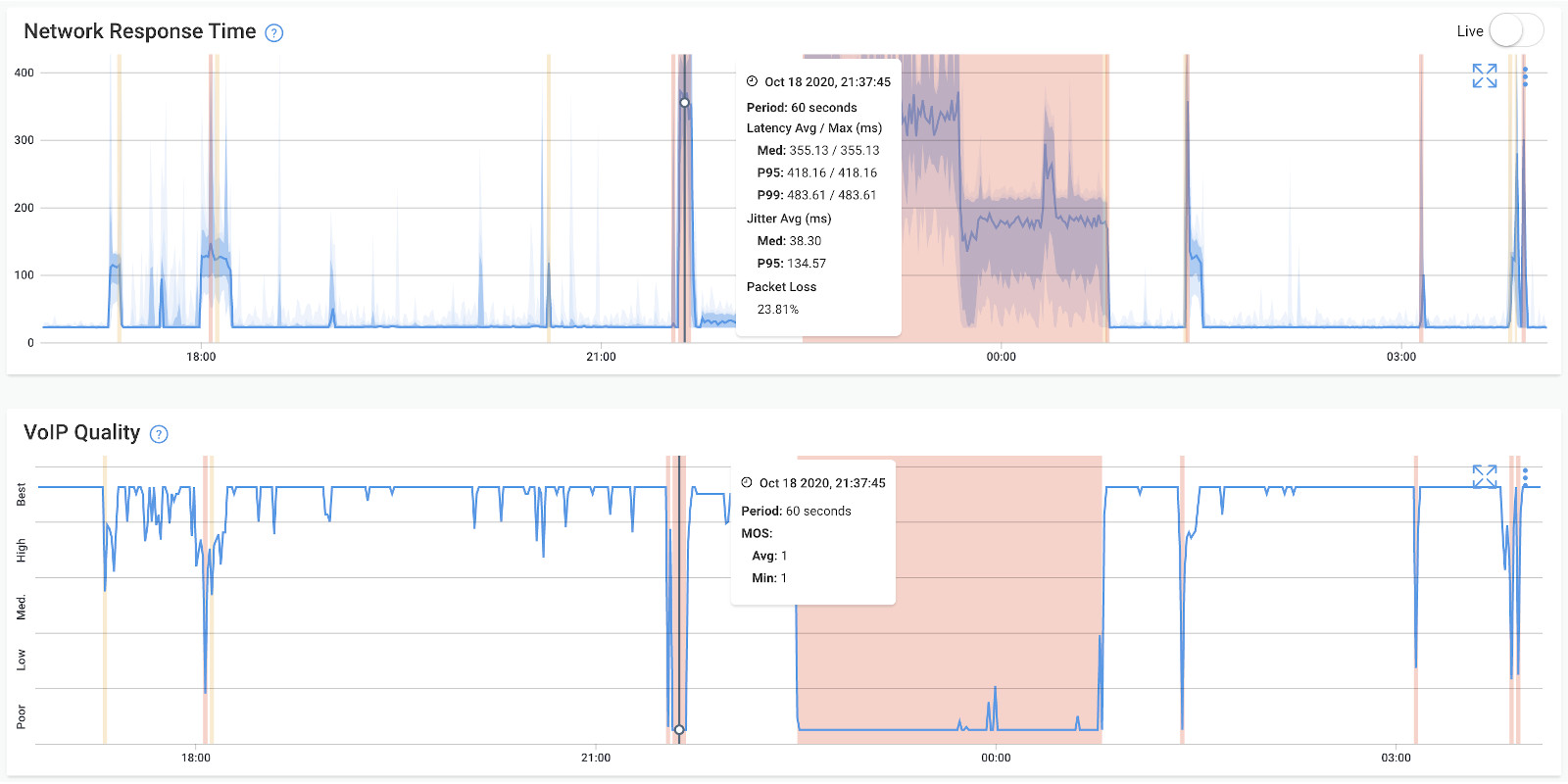

Microsoft Teams, like any software, can encounter various error messages or alerts related to performance issues. When you’re tackling Microsoft Teams monitoring, it’s important to understand what these errors mean to give you a head start when troubleshooting.
Remember, encountering these errors doesn't necessarily mean there's a persistent issue with Teams itself – network performance can play a significant role. Monitoring network metrics and using tools like Obkio can help you identify the root causes of these errors and proactively address performance-related challenges, ensuring a smoother Microsoft Teams experience.
Here are some common error messages and alerts you might come across:
This generic error message can appear when there's a problem with your connection, server issues, or other technical glitches affecting Teams' functionality. This error message is a catch-all response that Microsoft Teams displays when it encounters a problem that prevents it from functioning as expected. While the message itself may not provide specific details about the issue at hand, it serves as an indicator that something is amiss in the Teams ecosystem.
If you encounter this error, consider checking your network connection, verifying that Microsoft Teams services are operational, and exploring potential client-side issues. Monitoring network performance, using compatible devices and software, and keeping your Teams app up to date are essential steps to minimize the occurrence of this error and ensure a smoother Teams experience.
The alert "Your Internet connection is unstable" is a reminder from Microsoft Teams that your digital highway might be a little bumpy at the moment. It's a heads-up that your network connection might not be in its A-game state, and this can have a direct impact on the quality of your audio and video during Teams calls or meetings.
Use Obkio’s Network Device Monitoring feature to check if other devices are hogging your bandwidth, ensure you're not too far from your Wi-Fi router, and consider taking a break from bandwidth-intensive activities while on that important Teams call.
When you encounter the message "Poor network quality" while using Microsoft Teams, it's like a signal flare warning you that your digital highway might be experiencing a bit of a traffic jam.
This alert pops up when the conditions of your network are less than ideal, and it's waving a red flag that this could cause a range of problems, from hiccupy call quality to dragging down your screen sharing and file uploads.
Maybe it's time to give your Wi-Fi a little love, ensure no bandwidth-hogging activities are happening simultaneously, or consider upgrading your Internet plan if this has become a recurring theme.
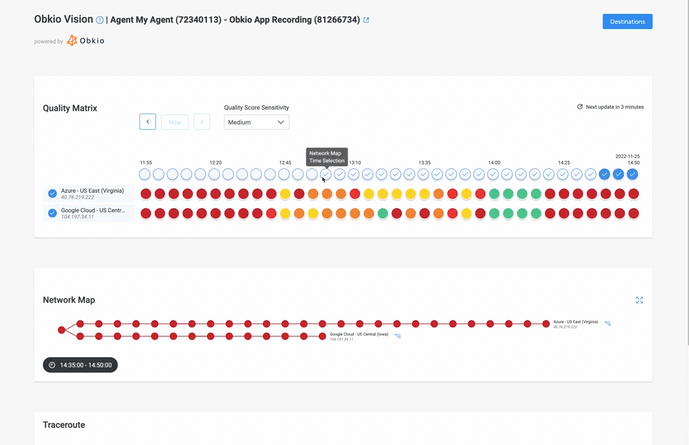

When you come across the frustrating "Failed to send message" error in Microsoft Teams, it's like trying to send a carrier pigeon with an important note only to watch it fly in circles and crash.
This error is a clear sign that something's amiss with your chat messages, and it's waving a little red flag that there might be gremlins playing havoc with your network or even mischievous server shenanigans. Here's a closer look at what's likely causing this error and how you can decode its message:
Consider checking your network's health using Obkio’s Network Monitoring tool, ensuring your Internet connection is stable, and giving Teams a little time to sort out any potential server hiccups.
When the "Call quality issues" alert pops up in Microsoft Teams, it's spotlighting potential problems with your call quality that can range from annoying audio dropouts to pesky echoes and video freeze-frames.
Check your network's tempo and measure packet loss to identify if data packets are delivering smoothly or if there is potential packet loss?
Make sure bandwidth-hogging activities aren't stealing the spotlight while you're on an important call, and consider upgrading your network if call quality issues are recurring.
Learn how to measure VoIP Quality using MOS Score (Mean Opinion Score) & Obkio’s VoIP monitoring solution to identify poor VoIP Quality issues & dropped calls.
Learn more

When you encounter the frustrating "Trouble connecting to the call" error in Microsoft Teams, it's like trying to catch a train to an important destination but finding the platform mysteriously closed.
This error is a clear signal that your journey to the call might hit a few roadblocks, and it's pointing a finger at potential network issues that are standing in the way of your connection. Hardware
Consider giving your network a little checkup. If you're on a corporate network, chat with your IT team to ensure your firewall and proxy settings are playing nice with Teams. Don't forget to keep your device and Teams app up to date; a quick software refresh can sometimes be the ticket you need to hop right back into the call.
When you come across the frustrating "Unable to share screen" message in Microsoft Teams, it's like trying to showcase your amazing presentation to a packed room only to find that the projector's bulb has blown out.
This error message is a digital road sign warning you that your screen-sharing plans might hit a speed bump due to a wobbly network or a potential technical glitch.
First, check your network's stability and ensure you're on a solid connection and not competing with bandwidth-hungry activities.
Make sure your device and browser are up to date, and consider adjusting your security settings if they're clashing with screen sharing.
The "File upload/download failed" error in Microsoft Teams signals trouble when trying to transfer files within Teams.
When "File upload/download failed" barges into your file-sharing plans, don't let it slam the door on your collaboration dreams. First, check the digital traffic and ensure your network isn't overcrowded and your bandwidth is free and clear. If your file is on the larger side, consider compressing it before uploading.
When the "Meeting is experiencing network issues" alert pops up in Microsoft Teams, this alert acts as your onboard weather report, signalling that the ongoing meeting might encounter some rough patches due to network-related turbulence.
Check your network's health and ensure your connection is stable and bandwidth isn't hogged by other data-hungry activities. If possible, consider shifting to a wired connection for a more reliable link.
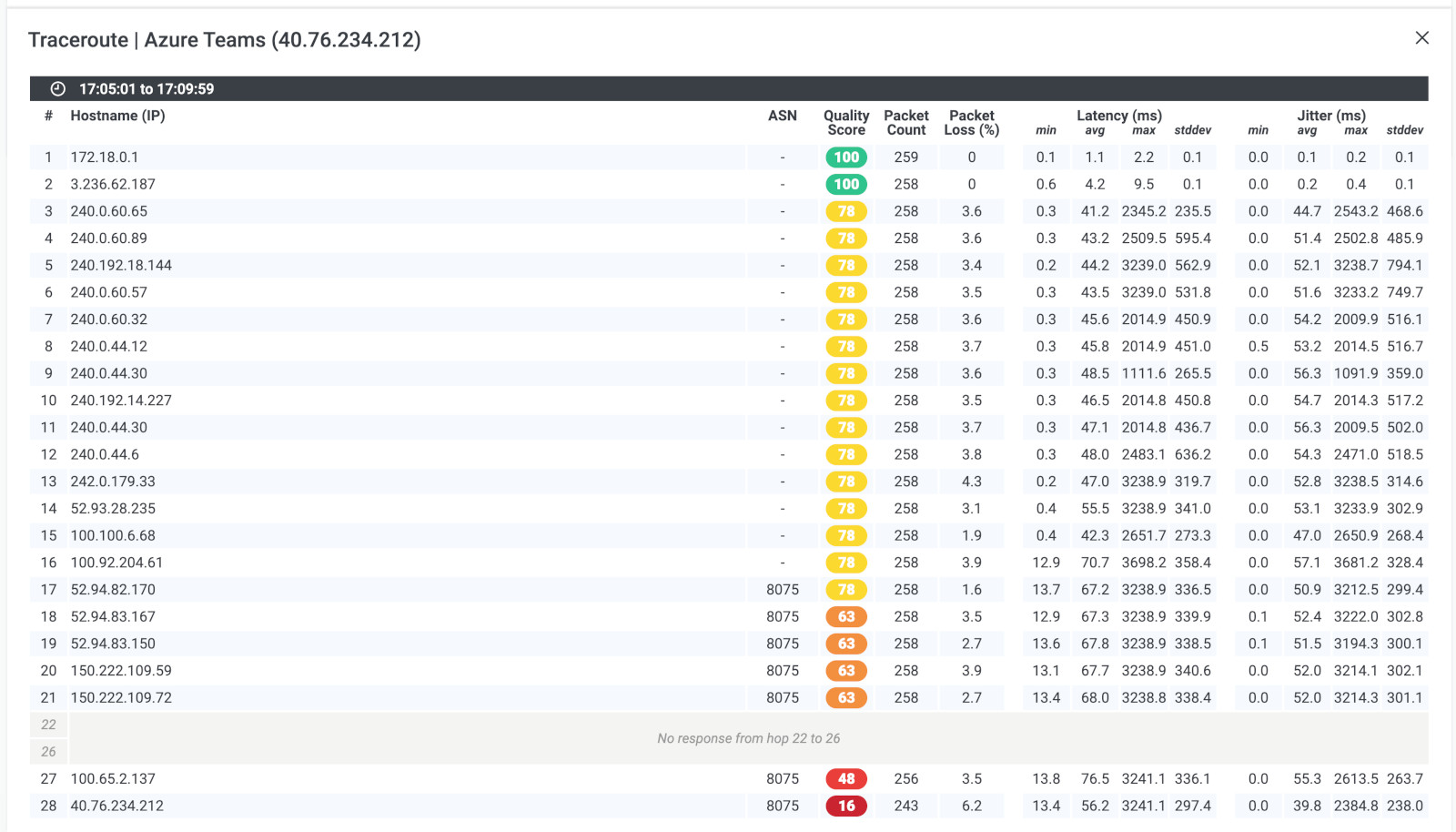 Obkio Vision: Visual Traceroute Tool monitoring Microsoft Teams performance
Obkio Vision: Visual Traceroute Tool monitoring Microsoft Teams performance
Encountering the frustrating "Server not responding" message in Microsoft Teams indicates the server hosting your Teams playground might be taking an unexpected coffee break.
This message serves as a digital SOS flare, suggesting that something might be amiss either on the server's end or somewhere along the data highways that connect you to it. .
So, when "Server not responding" interrupts your Teams journey, consider taking a few steps to troubleshoot:
- Check your Internet connection's health
- Ensure you're not experiencing any widespread network issues
- Verify that your firewall and proxy settings are in harmony with Teams' requirements.
Microsoft Teams monitoring with Obkio can uncover a range of issues that might be affecting your Teams experience. With continuous Microsoft Teams monitoring, you’ll likely be able to proactively identify many of these issues even before they affect your end users. After all, once end-users start feeling the effects, the pressure is on.
In addition to identifying performance issues, a tool like Obkio will also collect all the data you need to troubleshoot them. With details about what the issue is, when and where it happened in your network, and why, your Microsoft Teams troubleshooting journey will be a whole lot easier.
Learn how to use Network Monitoring tools for Microsoft Teams troubleshooting to identify and fix common teams performance and connection issues.
Learn more

By continuously tracking key metrics and performance indicators, Obkio’s Microsoft Teams monitoring features can help identify and troubleshoot these common issues:
High latency can lead to delays in audio and video transmission during Microsoft Teams meetings, causing awkward pauses and interruptions in conversations. Monitoring tools like Obkio can measure latency by measuring the time it takes for data packets to travel between users, helping identify if latency is impacting call quality.
When troubleshooting latency issues affecting Microsoft Teams:
- Troubleshoot your network connection for stability and consistency.
- Close bandwidth-intensive applications or downloads that might be causing congestion.
- Consider using a wired connection instead of Wi-Fi for more reliable performance.
Packet loss occurs when data packets are lost or arrive out of order, resulting in distorted or incomplete audio and video. Monitoring packet loss can track packet loss rates, revealing if it's affecting the quality of calls and meetings.
When troubleshooting packet loss issues affecting Microsoft Teams:
- Check for physical issues with your network cables or Wi-Fi signal.
- Update your router's firmware and consider adjusting Quality of Service (QoS) settings.
- Contact your Internet Service Provider (ISP) to investigate and address packet loss.
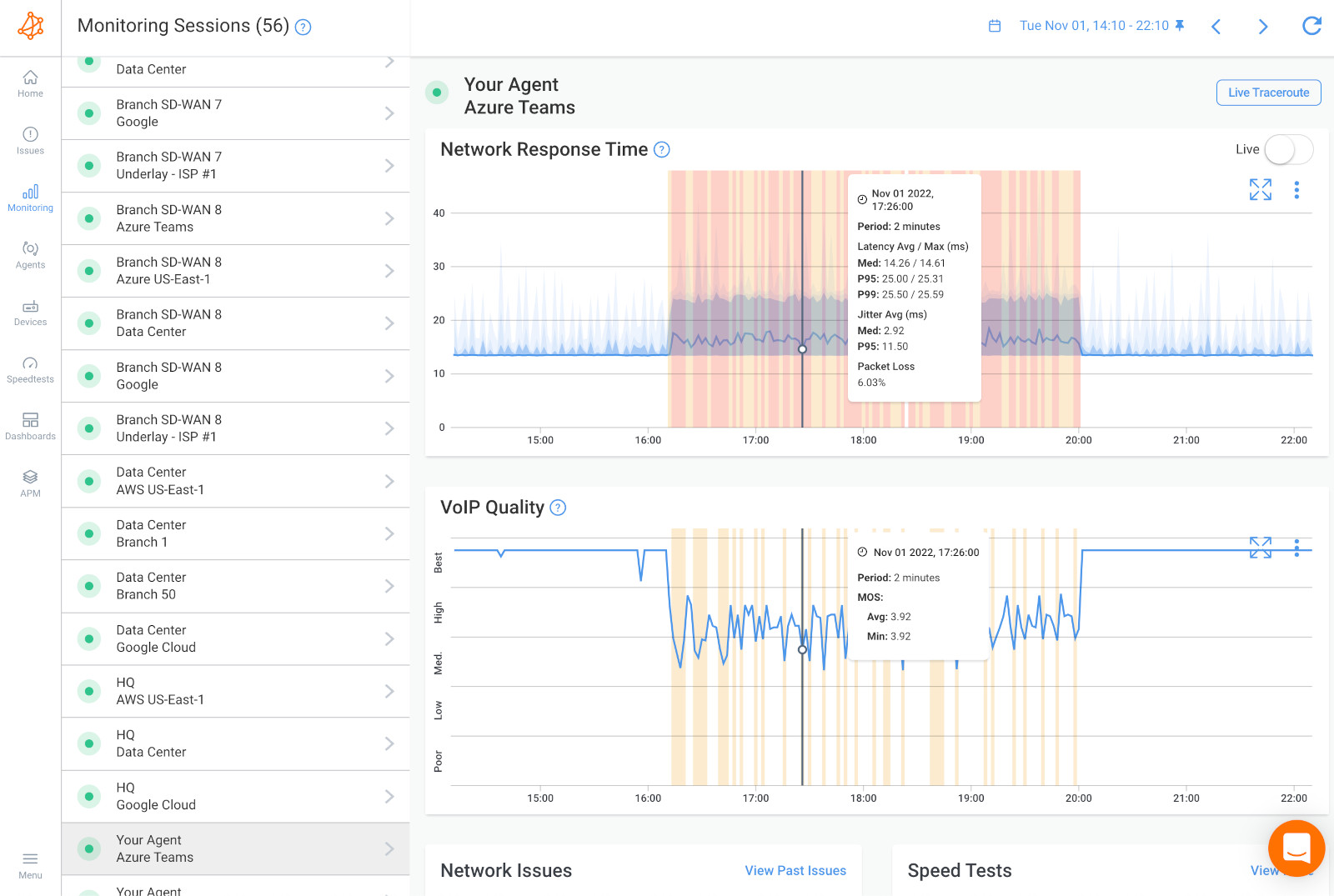
Jitter causes inconsistent delays in packet delivery, leading to choppy audio and video. Monitoring tools like Obkio can measure jitter and analyze jitter levels over time to determine if it's contributing to poor communication experiences.
When troubleshooting jitter issues affecting Microsoft Teams:
- Minimize background activities that could consume bandwidth.
- Ensure your router is functioning properly and isn't overheating.
- Use a Virtual Private Network (VPN) with better jitter control if your organization permits it.
Insufficient available bandwidth can cause audio dropouts, pixelated video, and overall poor call quality. Measuring bandwidth helps assess whether network resources are being adequately allocated to support Teams usage.
When troubleshooting bandwidth issues affecting Microsoft Teams:
- Prioritize Teams traffic on your network by adjusting QoS settings.
- Limit simultaneous video streaming or large downloads during important meetings.
- Upgrade your internet plan if consistent bandwidth issues persist.
Obkio’s Network Monitoring tool can calculate Mean Opinion Score (MOS) based on user feedback, giving insights into VoIP Quality and the overall audio quality of calls and identifying if improvements are needed.
When troubleshooting call quality issues affecting Microsoft Teams:
- Use a wired headset to improve audio quality and reduce background noise.
- Avoid multitasking with other applications during calls to ensure better performance.
- Ensure your microphone and speaker settings in Teams are configured correctly.
Microsoft Teams monitoring can detect audio problems such as static, echo, or one-way audio, as well as video issues like freezing or blurry visuals.
When troubleshooting audit and video issues affecting Microsoft Teams:
- Close other applications that might be using your device's camera or microphone.
- Update your audio and video drivers to the latest versions.
- Test your camera and microphone in other applications to identify hardware issues.
Delays or frozen screens during screen sharing can hinder effective collaboration. Microsoft Teams monitoring helps track the performance of screen-sharing features and highlights any issues.
When troubleshooting screen sharing problems affecting Microsoft Teams:
- Opt for sharing a specific application window instead of the entire screen.
- Pause unnecessary background processes to free up system resources.
- Restart the screen-sharing session or try sharing from a different device.
Some devices or operating systems may not fully support Teams features. Microsoft Teams monitoring and Network Device Monitoring can reveal if certain devices are causing compatibility problems.
When troubleshooting device compatibility problems affecting Microsoft Teams:
- Ensure you're using a supported device and browser for Teams.
- Update your device's operating system and browser to the latest versions.
- Clear browser cache and cookies before joining a Teams session.
Network Monitoring tools can provide real-time alerts about server outages or service disruptions, enabling prompt action and communication with users.
When troubleshooting server outages affecting Microsoft Teams:
- Check the Microsoft Teams Service Health page for any reported outages.
- Wait for a while and try again later, as server issues are often resolved promptly by Microsoft.
Users encountering difficulties logging in or accessing Teams can be promptly identified through Microsoft Teams monitoring, allowing IT teams to address authentication issues.
When troubleshooting authentication failures affecting Microsoft Teams:
- Double-check your login credentials for accuracy.
- Try logging in from a different device or browser to isolate the issue.
- Reset your password if necessary and ensure multi-factor authentication is properly configured.
Microsoft Teams monitoring can highlight performance discrepancies based on different geographic locations, helping organizations optimize network configurations and resources. A monitoring tool like Obkio monitors Teams performance using Monitoring Agents deployed in different locations, making it easy to identify what geographic locations are experiencing Microsoft Teams issues and why.
When troubleshooting geographic variations affecting Microsoft Teams:
- Contact your IT department to optimize network settings for better performance in your location.
- Use a VPN to connect through a server closer to the Teams data center.
Microsoft Teams monitoring can uncover delays when joining meetings, indicating potential network or server-related problems affecting the meeting experience.
When troubleshooting meeting joining delays affecting Microsoft Teams:
- Restart Teams or your device to refresh any cached data.
- Test joining meetings with different devices to identify if the issue is device-specific.
- Contact your IT support if the issue persists to check for network or server problems.
Network Monitoring tools like Obkio can detect failures in sending or receiving files within Teams chats or channels, helping troubleshoot file-sharing issues.
When troubleshooting file transfer failures affecting Microsoft Teams:
- Ensure the file size and type are supported by Teams.
- Try sending the file in a different format or compress it before sending.
- Verify that your network connection is stable and not experiencing network disconnections.
Microsoft Teams monitoring can track instances of the Teams app crashing or becoming unresponsive, allowing IT teams to investigate and address the root causes.
When troubleshooting application crashes affecting Microsoft Teams:
- Close other applications that might conflict with Microsoft Teams performance.
- Update your Teams app to the latest version or try reinstalling it.
- Check for software conflicts or system updates that could be causing crashes.
Network Monitoring tools provide ongoing insights into service health and performance trends, enabling organizations to address any gradual degradation in Teams' performance.
When troubleshooting service degradation affecting Microsoft Teams:
- Keep an eye on the Microsoft 365 Service Status page for any reported issues.
- Clear your browser cache and cookies to resolve minor display or performance issues.
- Contact Microsoft support if you suspect a broader service degradation.
How Network Performance Affects Microsoft Teams Performance: The Need for Microsoft Teams Monitoring
Network performance plays a critical role in the overall Microsoft Teams experience. Since Teams is a cloud-based collaboration platform, it heavily relies on a stable and high-performing network infrastructure to deliver its full potential.
Let’s look into how exactly network performance affects Microsoft Teams:
- Call Quality: For audio and video calls in Teams to be clear and uninterrupted, a reliable network connection is essential. Poor network performance can result in call drops, audio distortions, and video lags, leading to frustrating and unproductive communication experiences.
- Screen Sharing and Presentations: When sharing screens or presenting content, a stable network is crucial. Inadequate network performance can cause delays in screen updates, making it difficult for participants to follow presentations in real-time.
- File Sharing and Collaboration: Microsoft Teams allows users to share files and collaborate on documents in real time. Slow network speeds can significantly hamper file transfer, synchronization, and co-authoring experiences, affecting team productivity.
- Instant Messaging and Presence: The ability to send instant messages and see the online status of colleagues is a fundamental aspect of Teams. Network issues may cause delays in message delivery and inaccurate presence information.
- Meeting Joining and Loading Times: Slow network connections can lead to longer wait times when joining online meetings or loading chat histories, resulting in wasted time and reduced efficiency.
- Live Events and Webinars: Broadcasting live events and webinars through Teams requires a stable network connection to ensure smooth streaming and uninterrupted audience engagement.
- Video Conferencing and Breakout Rooms: Teams offers video conferencing and breakout room features for virtual meetings. Network performance directly affects the quality of video streams and the overall collaborative experience in breakout rooms.
- Mobile App Experience: Teams' mobile app relies on network connectivity to provide on-the-go access to communications and documents. Poor network performance on mobile devices can hinder productivity when users are away from their desks.
Network performance has a direct impact on the usability, quality, and reliability of Microsoft Teams. To ensure a seamless and productive collaboration experience, businesses need to monitor and optimize their network infrastructure, ensuring that it can handle the demands of Teams' communication and collaboration features. Tools like Obkio's Network Monitoring can be instrumental in maintaining an efficient and robust network for optimal Microsoft Teams performance.
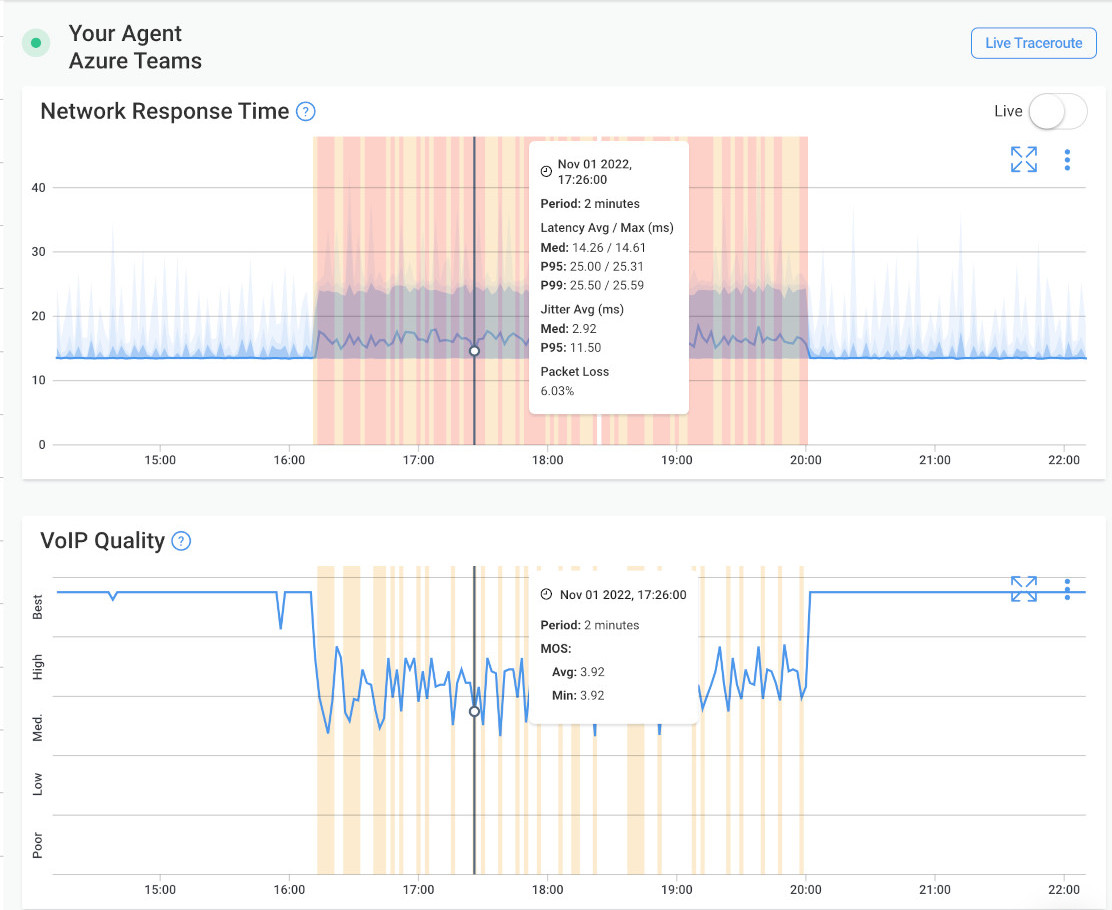
Microsoft Teams is not immune to occasional hiccups, disruptions, or even full-blown outages. These instances can not only hinder productivity but also lead to frustration among users who rely on Teams for seamless teamwork.
A Microsoft Teams outage refers to a period during which the Microsoft Teams service becomes unavailable or experiences significant disruptions, rendering users unable to access or use its features as intended. During an outage, users may encounter issues such as:
- Inability to Sign In: Users may be unable to log in to the Teams application, preventing them from accessing chats, meetings, and other collaboration tools.
- Failed Calls and Meetings: Ongoing calls or scheduled meetings may be disrupted, with participants experiencing call drops, poor audio/video quality, or an inability to join meetings.
- Chat and Messaging Delays: Messages might not be delivered promptly, causing delays in communication and hindering real-time collaboration.
- Inaccessible Files and Channels: Users may not be able to access files, documents, or shared channels within Teams, impeding collaborative work.
- No or Limited Access to Features: Certain features, such as screen sharing, file uploads, or integrations, may become temporarily unavailable.
- Presence and Availability Issues: User presence indicators may not update accurately, leading to misunderstandings about colleagues' availability.
- Notification Failures: Notifications about new messages, mentions, or upcoming meetings might not be received.
Microsoft Teams outages can be caused by a variety of factors, including server issues, network disruptions, software bugs, maintenance activities, or even unexpected spikes in user activity. These outages can vary in duration, from brief interruptions to extended periods of service unavailability.
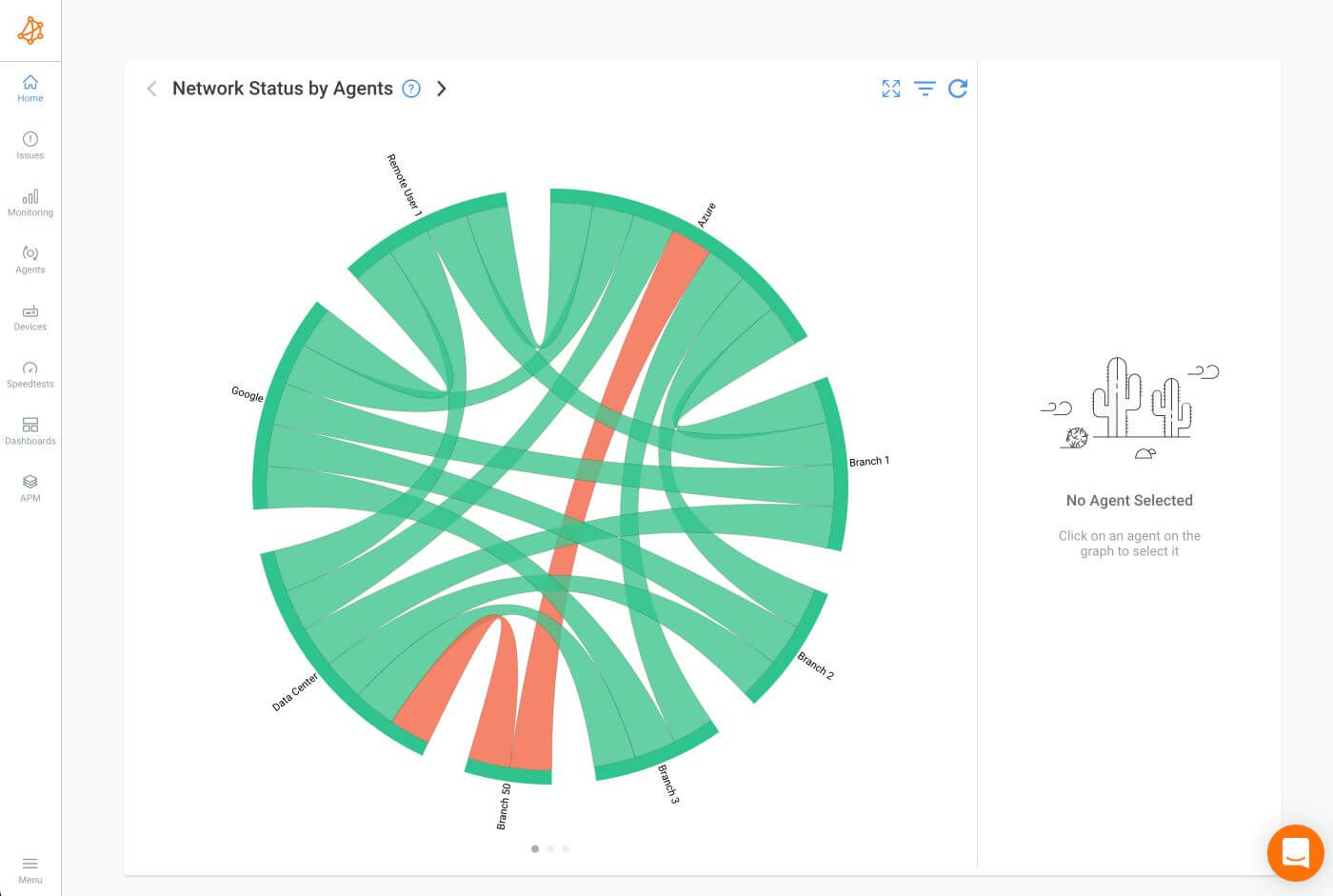
Proactively monitoring Microsoft Teams' performance and responsiveness can help organizations quickly identify and address potential outages, ensuring minimal disruption to communication and collaboration efforts. Monitoring also plays a crucial role in diagnosing the root causes of outages, enabling IT teams to implement effective solutions and prevent future occurrences.
Here’s how:
Real-Time Monitoring: Network monitoring & Microsoft Teams monitoring tools continuously track the performance and availability of Microsoft Teams services in real-time. They establish a baseline for normal operations, which allows them to promptly identify any deviations or disruptions.
Immediate Alerts: When an outage occurs, monitoring tools can send instant alerts to administrators or IT teams. These alerts provide early warning, allowing them to take swift action to address the outage and communicate the situation to users.
Distinguishing Local vs. Widespread Issues: Microsoft Team monitoring helps differentiate between localized issues (such as problems with a specific user's device) and broader outages affecting multiple users or regions. This differentiation is crucial for prioritizing troubleshooting efforts.
Root Cause Analysis: Monitoring tools gather data on various aspects of Microsoft Teams' performance, including network connectivity, server response times, and application responsiveness. This data assists IT teams in conducting thorough root cause analysis to determine the source of the outage.
Performance Metrics: Monitoring tools provide detailed metrics on call quality, latency, packet loss, and more. By analyzing these metrics during an outage, administrators can gain insights into the specific aspects of Teams' functionality that are impacted.
Historical Data: Monitoring tools collect historical data on Teams' performance over time. This data enables IT teams to identify trends, recurring issues, and patterns of outages, helping them proactively address potential problems.
Reduced Downtime: With immediate alerts and detailed insights, monitoring allows IT teams to quickly identify and resolve outages, minimizing downtime and its impact on productivity.
In addition to Microsoft Teams monitoring, using Obkio’s Network Monitoring tool and the very same setup we described earlier in this article, you can monitor a variety of other Microsoft apps and services.
Obkio’s Microsoft Azure Monitoring Agent monitors network performance between your network and the Microsoft Cloud, which means that it can monitor any of Microsoft’s cloud services and apps. All of these apps and services are affected by network performance in one way or another, so it’s important to keep an eye on them too.
Microsoft Network Performance: Microsoft Network Monitoring helps businesses ensure network stability, security, and performance. It empowers IT teams to stay ahead of potential issues, boost productivity, and deliver seamless experiences for users, ultimately contributing to the overall success and competitiveness of the organization.
Office 365: Office 365 includes a suite of popular productivity apps, such as Word, Excel, PowerPoint, and Outlook. Monitoring Microsoft network performance towards these apps can help you identify any issues that may be impacting your team's ability to work efficiently and collaboratively.
Microsoft Azure: Azure is Microsoft's cloud computing platform, and also where Obkio’s Microsoft Monitoring Agent is hosted. Microsoft Azure network monitoring can help you ensure the reliability and performance of your cloud-based applications and services.
Azure ExpressRoute: Azure ExpressRoute is a private, dedicated connection between your on-premises infrastructure and Azure datacenters, providing a more reliable and secure connection than a typical internet connection. By monitoring Azure ExpressRoute, you can ensure that your connection to Azure is performing optimally and that any issues are detected and addressed promptly.
Exchange Server: Exchange Server is a popular email server used by many businesses, and monitoring it can help you ensure that your email communications are working smoothly and securely.
SharePoint: SharePoint is a web-based collaboration platform that allows teams to work together on documents, projects, and other content. Monitoring SharePoint can help you identify any issues that may be affecting your team's ability to collaborate effectively.
Microsoft Dynamics 365 CRM: Dynamics 365 CRM has become a vital tool for organizations to effectively manage customer relationships, streamline processes, and drive growth. By continuously monitoring key performance metrics with Dynamics 365 performance monitoring, businesses can promptly identify and resolve performance issues to maximize the efficiency and usability of their Microsoft Dynamics 365 CRM instance.
Learn how to monitor network performance of Microsoft Azure ExpressRoute between your on-premise infrastructure, up to the Microsoft cloud.
Learn more

Microsoft Teams monitoring isn't optional, it's essential. With 75% of Teams issues stemming from network problems, waiting for users to complain means productivity has already suffered.
Obkio's approach combines traditional network monitoring with specialized Teams testing. Obkio's agents join actual meetings every minute, monitoring from three perspectives—user devices, network infrastructure, and Microsoft's platform. This reveals not just that problems exist, but exactly where they originate and how to fix them.

Key benefits:
- Detect issues before users notice (proactive vs. reactive)
- Pinpoint root causes instantly (user, network, or Microsoft)
- Reduce troubleshooting time from hours to minutes
- Maintain consistently high call quality across your organization
- Optimize network resources based on actual data
Ready to transform Teams monitoring from reactive firefighting to proactive optimization?













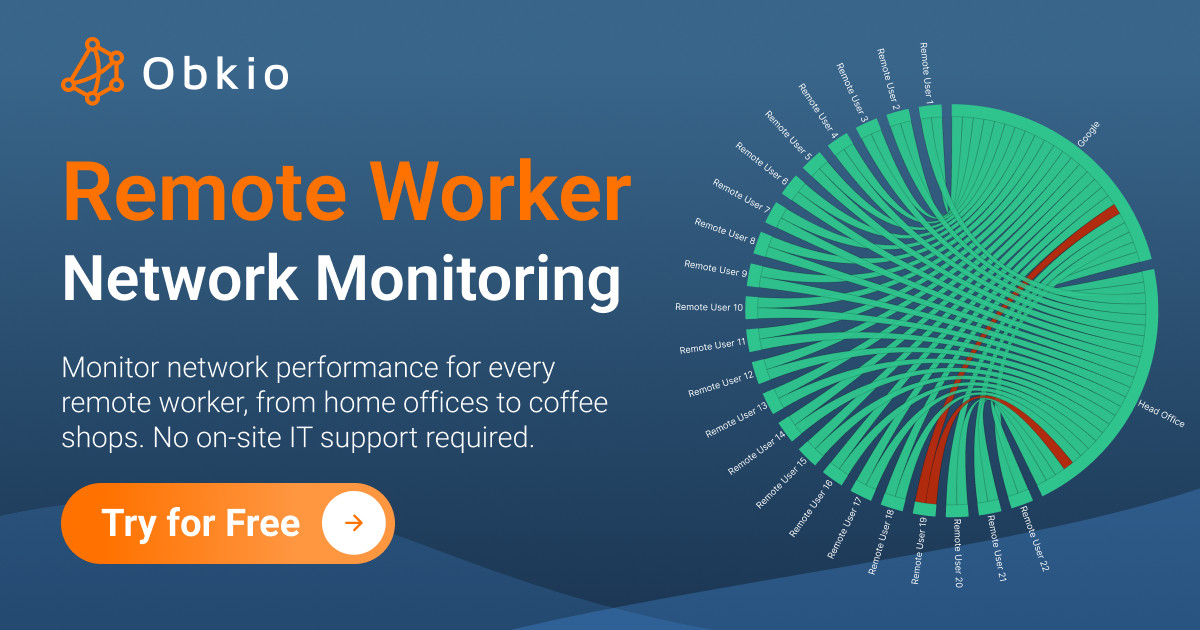













 Obkio Blog
Obkio Blog






